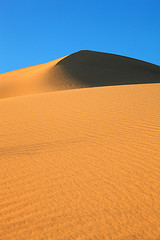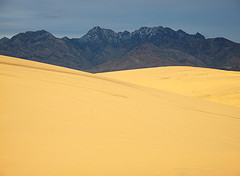
#1 – Watch where you walk
Avoid walking through the middle of dunes, since that’ll mess up those nice lines in the sand and ruin any opportunity to photograph the dune. Instead, walk around dunes, or only walk through dunes you know you don’t want to photograph.
#2 – Look for shadows
One of the most simple ways to add strength to a dune photo is to include strong contrast between a sunlit sand dune and the shadow behind it. The easiest way to do this is wait for sunrise or sunset when the sun is low on the horizon and casts long shadows. Then, just look for dunes that run North or South.
#3 – Look for layers

#4 – Avoid putting down your camera bag
Even on seemingly calm days, a lot of sand tends to move around in dune country. So, if you put down your camera bag on the sand, you’ll likely get sand in all the small crevices of your bag (and if your bag is open, the sand will likely end up on your camera or lenses). This is a real pain to clean, so hold your bag or hang it from your tripod when you’re taking stuff out.
#5 – Avoid the biggest dunes
When you first see a large field of sand dunes, you might think of always heading to the largest dunes in the field, but these don’t always make the best photographs. The biggest dunes are often the most visited, so they’ll likely have human footprints all over them. If you’re looking to photograph some undisturbed dunes, then head out towards the edges of the dune field.
#6 – Switch your lenses before venturing into the dunes
Last week, I talked about the importance of being careful when and where you change your camera lenses. With all the sand that’s constantly blowing around in dune country, it’s a good idea to avoid changing lenses out there. So, before you head out on a hike in the dunes, make your best guess about what lens you’ll be using out there and mount that lens on your camera.
What did I miss?
If you have another tip for photographing sand dunes, please share it with us by leaving a comment below. Thanks! 🙂
If you enjoyed this article, and would like to read more, please signup for free updates by email or RSS.
 About the Author: Steve Berardi is a naturalist, photographer, computer scientist, and founder of PhotoNaturalist. You can usually find him hiking in the beautiful mountains and deserts of Southern California.
About the Author: Steve Berardi is a naturalist, photographer, computer scientist, and founder of PhotoNaturalist. You can usually find him hiking in the beautiful mountains and deserts of Southern California.

Use a PL filter when photographing dunes.
Living on the east coast the sand dunes are covered with vegitation yet still present some interesting photos opportunities. My question is, in what light or time of day would you recommend taking the photos. These are on beaches with people so early morining sunrise in the east would be my quess. Unless there is a lot of clouds the sunsets are more difficult to manage.
As tempting as it might be don’t take your shoes off to go barefoot. In most areas with dune fields, especially in the Southwest, the sand surface can reach 140 degrees Fahrenheit by 1:00p.m. at an environmental temperature of 80 degrees Fahrenheit. This can seriously burn your feet, and cause blisters.
At dunes like the Great Sand Dunes National Park in Colorado with the highest sand dunes in North America, at 750 Feet, on top of the normal elevation altitude sickness can affect those not yet acclimated. It is imperative to get off the dune to an altitude where you can breathe and the dizziness ceases if you are affected.
Lightning, especially during the afternoon thunderstorms, always strikes the highest point. Be prepared to get off the Dunes in a hurry and keep an eye out for storms. Lightning strikes can be fatal.
Travel light, a good tele-zoom from 50-300mm, polarizer and ND filters, if you got it a tele-converter, and a wide-angle for those big panorama shots. On top of my regular bags I use special zip locs larger than a 1 Gallon freezer bag to keep the sand out of my goodies.
Carry plenty of water; dehydrated photographers drop stuff!
If you are using a tripod and not just stabilization you might want to consider bringing the tripod snowshoes because just as in the snow, your tripod feet will sink in the sand.
Hey Steve,
Thats some really fantastic piece of tips for photographing Sand dunes. Infact i was in a desert in North India couple of weeks back just exploring the possibilities of capturing the dunes in a different way. Few things what I would like to add from my end ( which i tried ) are
a. Try to get intimate .. get close to the dunes with patterns and shapes
b. Get a context .. having a thorny bush, or a reptile or a bird or a mammal in context to the dunes really adds life to the image
Thanks once again for this short and beautiful handy tip set for photographing dunes.
Cheers,
Shiv
India
I live by the Great Sand Dunes National Park in Hooper Colorado. I have found that timing is very important. Late afternoon sunlight creates great shadows which add impact to the photos.
Coastal dunes like the Marlo sand blow at Rainbow Beach in Queensland Australia are good too because you can get a seascape in the background . But number one with dunes. Pick a CALM day or the wind will get the sand into everything regardless of how careful you try to be. Leave your ‘best’ gear safely in the car or at home and take one ‘was your best’ camera in a ziplock bag with the lens of choice already on it. .
The dunes at White Sands National Monument add the further complication that being white, they meter like snow. Watch your histogram! Plus the gypsum that gives the dunes the white color may be even less desirable than silica based sand. Any moisture, say from condensation and the gypsum, would probably be very bad.I use 2 camera bodies, with a 16-50 mm on one and a 50-135 on the other. I don’t change lenses at dunes ever.
Happy New Year Steve!
Thanks again for the tips, my favorite is the one on getting the shadows. All very useful and very important for the best shots and protection of your equipment.
I was caught in one of those sand storms, which came very suddenly, at Great Sand Dunes National Park when I was trying to climb it. Fortunately, I was still in the lower third of them, and always carry a protective plastic bag ready. I had to act very fast, not to mention I was almost blinded by the blowing sand on my way down.
Sand dunes are bright and this brightness tends to overload the sensors causing pictures to appear too dark. Be sure to be aware of this possibility and to compensate for it if necessarily.